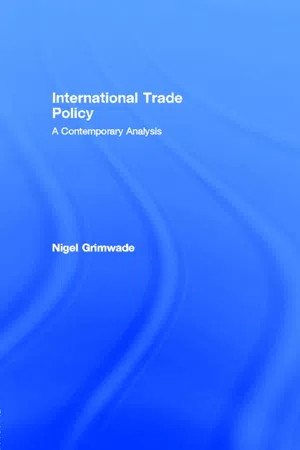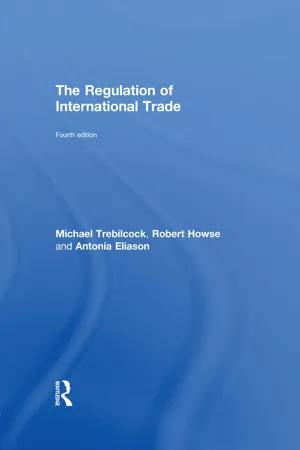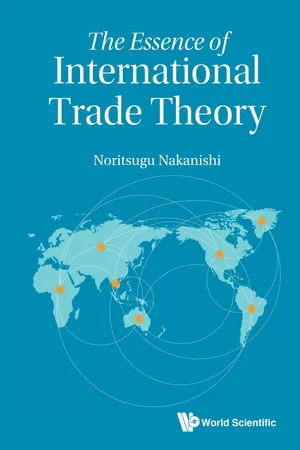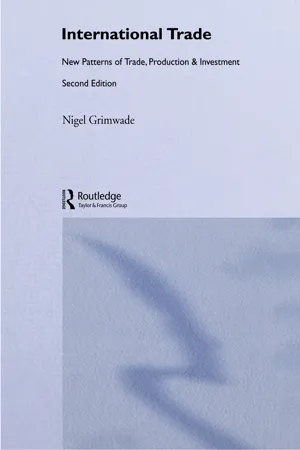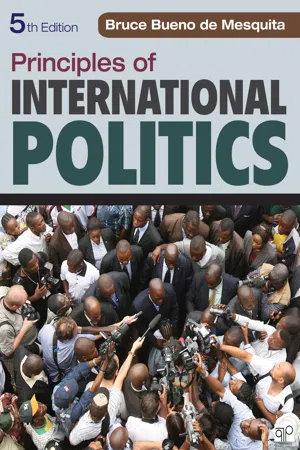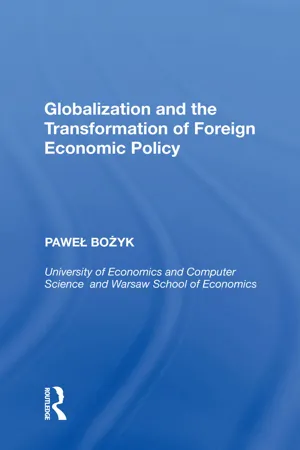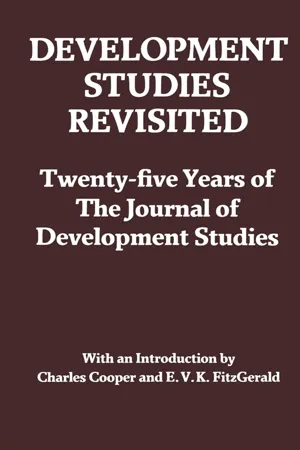Economics
Tariffs
Tariffs are taxes or duties imposed on imported goods, making them more expensive for domestic consumers. They are used to protect domestic industries from foreign competition, generate revenue for the government, and address trade imbalances. Tariffs can lead to higher prices for consumers, trade disputes between countries, and shifts in global supply chains.
Written by Perlego with AI-assistance
Related key terms
9 Key excerpts on "Tariffs"
- eBook - ePub
- W. Charles Sawyer, Richard L. Sprinkle(Authors)
- 2020(Publication Date)
- Routledge(Publisher)
While Tariffs are no longer a major form of tax revenue for the U.S. government, they still have important economic effects. For example, the tax—tariff—imposed on an imported good determines or influences what you consume and how much of the good you consume. Although the average tariff in the U.S. is approximately 4 percent, the tariff on many imported products remains quite high. Some Tariffs imposed by governments are designed as revenue Tariffs. A revenue tariff is an import tax levied on a good that is not domestically produced. There are some revenue Tariffs in the U.S., although they are rare. Revenue Tariffs are most common in the developing countries. Tariffs are designed primarily to be protective Tariffs. The purpose of a protective tariff is to protect a domestic industry from foreign competition. In this chapter, we will be concerned with the effects of Tariffs that are imposed to protect domestic industries. Types of Tariffs The simplest form of a tariff is a specific tariff. A specific tariff is expressed as a per-unit tax on imported goods, such as 6 cents per imported liter or $4 per imported ton. A specific tariff is relatively easy for a government to administer—it is a certain amount of money per unit of whatever is imported. However, if there are large differences in the imported price per unit, the effects of a specific tariff are not uniform across lower-priced and higher-priced items. For example, a specific tariff of $1,000 imposed on automobiles would yield a high percentage tariff relative to the import price of Hyundais and a low percentage tariff relative to the import price of Porsches. In this case, a specific tariff is regressive. Hyundais and Porsches are likely to be purchased by lower-income and higher-income consumers, respectively. As a result, the less well-off pay a larger percentage of their income in Tariffs than do those who are more affluent - eBook - ePub
International Trade Policy
A Contemporary Analysis
- Nigel Grimwade(Author)
- 2006(Publication Date)
- Routledge(Publisher)
2 INDUSTRIAL Tariffs
INTRODUCTION
In the period since the establishment of the GATT, great progress has been made in reducing Tariffs on industrial goods. Very little attempt was made to tackle the problem of nontariff barriers until the seventh (Tokyo Round) of 1973–9. Similarly, before the successful conclusion of the recent Uruguay Round, trade in agricultural goods was largely exempt from GATT rules. One result of this tariff-cutting process is that Tariffs are now much less important as an impediment to trade in industrial products. Increasingly, other types of barrier have become more important.However, it is not true that Tariffs no longer matter. High Tariffs still exist on particular products. Moreover, a country’s tariff structure may be more protectionist than the average level of its tariff suggests. This chapter begins by examining the economic effects of Tariffs and the procedure which is conventionally used for measuring the welfare loss from Tariffs. It continues with a discussion of some difficulties involved with the orthodox model and considers modifications which incorporate imperfections in both product and factor markets. Next, the relevance of tariff structure and the concept of the effective rate of protection are introduced. The chapter concludes with a survey of the process of tariff liberalisation up to and including the Uruguay Round.THE NATURE AND EFFECTS OF Tariffs
A tariff is a tax or levy on an imported product. It may take the form of either a specific or an ad valorem duty. In the case of a specific duty, the tariff is a fixed amount per unit of the product imported. An ad valorem duty is a tariff which is a certain percentage of the unit value. Generally, ad valorem Tariffs are more popular than specific Tariffs mainly because they keep pace with inflation. (A weakness is that they may import inflation to an otherwise inflation-free country.) However, specific Tariffs are still important. For example, prior to the Uruguay Round, roughly one-third of all tariff lines in the US were covered by specific duties, about 13 per cent in Japan and 10 per cent in the United States (Yeats, 1979). Ad valorem - eBook - ePub
The Regulation of International Trade
4th Edition
- Robert Howse, Antonia Eliason(Authors)
- 2013(Publication Date)
- Routledge(Publisher)
7 Border measures
Tariffs and quantitative restrictions
Tariffs OVERVIEW
Tariffs are essentially taxes on imported goods, and they, as well as other customs duties, must be applied in accordance with the Most Favoured Nation (MFN) principle discussed in Chapter 2 of this book. Additionally, WTO Members may, but are not obligated to, commit to binding certain customs duties that may generally be understood as committing to maximum duties for particular products.1 Binding is in accordance with the object and purpose of both the WTO Agreement and the GATT 1994. These two Agreements in their respective preambles recognize the desirability of ‘reciprocal and mutually advantageous arrangements directed to the substantial reduction of Tariffs and other barriers to trade’. Members’ commitments vary, are usually the product of multilateral trade negotiations, and are included in schedules of concessions which may be found in the annexes of the GATT.THE ECONOMIC EFFECTS OF A TARIFF
The economic effects of a tariff on both importing and exporting countries are best understood by first examining the case of a prohibitive tariff, a tariff that is so high that it prevents all imports. Here we draw on an example provided by Ruffin and Gregory.2 (See Figure 7.1 .)With a prohibitive tariff, the prices paid for shirts in each country are determined by the supply and demand curves in each country. To compare prices, we assume that US$2 = £1. If there was no tariff, prices would be the same in the two countries. The prohibitive tariff in America raises the price in America from US$6 to US$9. Consumers lose area A + B, but producers gain area A. The net loss to America is area B. In the UK, prices fall from £3 to £2, and producers lose area C + D, while consumers gain C. The gain to consumers is less than the loss of producers. The net loss to Europe is area D.One can next consider a non-prohibitive tariff, which does not preclude all imports of a product. Ruffin and Gregory graph this example as in Figure 7.2 . Before the nonprohibitive tariff, the price of the product is Pw . The tariff raises the price to Pw + T which is the world price plus the amount of the duty. Consumers lose area N + R + T + V. Producers gain N. The government gains the tariff revenue T, which equals the tariff per unit times the quantity of imports. The net loss is R + V. The tariff lowers imports from (q4 – q1 ) to (q3 – q2 - eBook - ePub
- Noritsugu Nakanishi(Author)
- 2018(Publication Date)
- WSPC(Publisher)
negative export tax, respectively. Unless necessary, we use simpler expressions such as “Tariffs” or “tariff policy” to refer to trade tax/subsidy policy.Methods of taxation: Specific tax (or unit tax) prescribes the amount of tax for a physical unit of a good. On the other hand, ad valorem tax specifies the amount of tax as a certain percentage of the value of a good. Suppose that a country imports good j and imposes import tariff on it. Let pjand pj∗ denote the domestic and world prices of good j, respectively.1 If a specific import tariff rate per unit of good j is given by tj, the domestic price must be equal to the sum of the world price and the specific rate, that is, pj= pj∗ + tj. On the other hand, if an ad valorem rate is given by τj× 100%, the domestic price must be equal to the world price multiplied by 1 + τj, that is, pj= (1 + τj)pj∗ .2 For a given ad valorem tariff rate, we can find a corresponding specific rate and vice versa. That is, if τjpj∗ = tj, we have pj= (1 + τj)pj∗ = pj∗ + τjpj∗ = pj∗ + tj. In view of this, we can say that the ad valorem tariff and the specific tariff are equivalent as far as the world price remains unchanged.7.1.1Small-Country Case
Consider an economy of a small country with two traded goods (good 1 and good 2). Let x ≡ (x1 , x2 ), y ≡ (y1 , y2 ), and z ≡ (z1 , z2 ) ≡ x − y be the vectors of consumption, production, and net import of the country, respectively. Further, let Dj(p, I) and Y(p) be the ordinary demand function for good j and the GDP function, where p ≡ p1 /p2 is the domestic relative price of good 1 in terms of good 2. The country imports good 1 under free trade. Let p∗ ≡ p1 ∗ /p2 ∗ and τ be the world relative price of good 1 and the ad valorem tariff rate on the import of good 1, respectively. Since p1 = (1 + τ)p1 ∗ and p2 = p2 ∗ , we have p = (1 + τ)p∗ . If the world price p∗ is given and fixed, the introduction of import tariff or an increase in the tariff rate gives rise to an increase in the domestic price p - eBook - ePub
International Trade
New Patterns of Trade, Production and Investment
- Nigel Grimwade(Author)
- 2020(Publication Date)
- Routledge(Publisher)
- Learning by doing effects (dynamic scale economies)
- Faster rate of product Innovation in research-intensive industries
- Industry trade balances narrow - less resistance to trade liberalisation
- Adjustment Costs
- No need for inter-sectoral re-allocation of factors (only intra-sectoral)
- Less need for relative factor prices to change
- Possibility of some structural unemployment due to wrong skills mix
- Distribution effects unlikely to be very great as relative factor prices less likely to change
value or goods imported. Tariffs generally raise the price of imports although not always by the full amount of the tariff. Thus, under certain circumstances, the incidence of the tariff may be borne both by the consumer in the importing country and the foreign supplier. The reason for imposing Tariffs may not always be protectionist. In poorer countries which lack an adequate base for raising sufficient revenues from the taxation of incomes, reliance is often placed on customs duties along with other forms of commodity taxation for the finance of public expenditure. In most cases, however, Tariffs reduce the economic welfare not only of exporting countries, whose access to foreign markets is thereby restricted, but also of the importing country imposing the duty.Figure 8.4The small-country partial equilibrium model of the effects of a tariffFigure 8.4 illustrates the effects on a small importing nation of the imposition of a tariff. The left-hand side of the diagram shows the demand and supply for a product in the importing country. Suppose the world price is OP0 . Suppose also that the importing country is a small trading nation which is unable to influence the world price of the product in question. Then, it can buy all that it wants from the rest of the world at the world price P0 , but nothing at all at a price of less than OP0 . D0 D0 is the demand curve for the product and S0 S0 the domestic supply curve in the importing country. Let us further assume that the product is a homogeneous product such that there is no difference between the product supplied by the foreign producer and that by the domestic producer. This ensures that the product will sell at one price only. In the absence of any tariff and disregarding any transport costs, consumers would pay the price P0 . (If domestic producers charge more than P0 , they will be unable to sell any of the product.) Domestic consumption would equal OQ,, domestic production OQ0 and imports QoQi. Q0Q1 is also equal to OQ4 in the right-hand side of the diagram. Now, suppose the authorities impose a tariff, T, The effect is to raise the pric of imports in the importing country to (1+T)Po. (Note that the world price is unaffected because the importing country is a small trading nation.) Domestic producers also raise their prices by the amount of the tariff because, if they do not, consumers will switch all their purchases from foreign to domestic suppliers. This will force domestic producers to raise their prices to choke off the excess demand. As a result of the increase in price, domestic consumption will fall to OQ3 , domestic production will rise to OQ2 and imports will fall to Q2Q3. Q2Q3 is equal to OQ5 - eBook - ePub
- Miltiades Chacholiades(Author)
- 2017(Publication Date)
- Routledge(Publisher)
VIIInternational Trade PolicyPassage contains an image
17
Forms of Trade Control
Chapter 16 demonstrates that free international trade is potentially better than no trade from the point of view both of the world as a whole and of each individual trading country. This thesis has never been successfully refuted, despite the fact that most arguments for protection are asserted with great conviction. Yet in the real world, the free flow of trade has been, as a rule, impeded by several trade-control devices, such as Tariffs, quotas, and exchange controls. Chapters 17 –20 analyze the effects of these trade-control devices. This chapter deals with the forms of trade controls.Trade controls can be classified into two major categories: those trade controls that directly influence prices, such as taxes and subsidies, and those that directly influence quantities, such as quotas and exchange controls.1 Taxes or subsidies, as well as quotas, may be imposed on exports or imports, so there are really four trade controls operating through prices and two trade controls operating through quantities, as shown in table 17.1 .In general, taxes (whether on imports or exports) can be imposed in any one of the following three ways:a ) The ad valorem basis: This tax, or “duty,” is legally fixed in the form of a percentage on the value of the commodity imported or exported, inclusive or exclusive of transport cost. For instance, if an ad valorem import duty of 10 percent is fixed on the value of imports, exclusive of transport cost, an importer of commodities valued at $100 is required to pay $10 import duty to the government. In general, iftais the ad valorem import duty, the importer is required to pay (1 +ta)pmper unit imported, wherepmis the price accruing to the foreign exporter andta pmis the tax revenue per unit imported.Table 17.1b ) The specific basis: This tax is legally fixed in the form of an absolute amount of domestic currency per unit imported or exported. For instance, if a tariff of $1 is imposed on every unit of a particular commodity imported irrespective of its price, an importer must pay $(pm + ts) per unit imported, wherepmis the price accruing to the foreign exporter andts - eBook - ePub
- Bruce Bueno de Mesquita(Author)
- 2013(Publication Date)
- CQ Press(Publisher)
Tariffs, or fair trade, as such policies are sometimes labeled, are classic private goods subject to many of the political considerations discussed in the context of the selectorate theory. Unregulated trade is a public good that is likewise subject to the political considerations addressed in that same theory. It should be evident that free trade benefits many, whereas fair trade benefits only a few. For the few, of course, the benefit from Tariffs may outweigh the value of the public benefit that everyone gets from free trade. Presumably, if no one benefited more from trade protection than from free trade (i.e., if the public-goods benefit outweighed the private-goods component for everyone), then there would be no Tariffs or other means of making imports less competitive. In this regard, we should note that Tariffs arise for more than one reason. Tariffs can be used to protect domestic industries from competition, as is commonly the case, but they can also be used to punish foreign governments that do not observe free-trade policies in their own right. President George W. Bush justified his call for a tariff on certain steel products in March 2002 by alleging unfair trade practices by Japan and Europe designed to bolster their steel industries at the expense of American industry. They countered—apparently correctly, given how readily the Bush administration negotiated a resolution favorable to Europe’s and Japan’s steel industries—by threatening retaliatory Tariffs to compel the United States to enforce its free-trade obligations under the WTO.In all these cases, domestic political considerations seem to be behind the use of Tariffs as foreign policy maneuvers. That still leaves us with questions about how Tariffs and other trade policies are used by political elites to pick and choose winners and, in doing so, pick and choose how to reward their winning coalition or harm their adversary’s coalition.TRADE AND DOMESTIC WINNERS AND LOSERS
We have seen that free trade, on average, provides cheaper goods and services to consumers. It also provides more abundant goods and services both in quantity and in diversity. Yet free trade has not been the norm throughout history. I have already hinted at why this is so. Free trade is a public good, but the effects of trade involve both public- and private-goods components. Trade affects domestic producers and sellers differently from importers, exporters, and consumers, and government trade policies affect the wealth of each of these groups differently. So the distribution of wealth in a society depends, in part, on governmental approaches to trade. If trade is unrestricted, then domestic producers for the domestic market are at a potential disadvantage, and foreign exporters and domestic importers could have an advantage. Each, depending on how well tied in they are to the leadership’s winning coalition, will lobby more or less effectively for their private, coalition-based gains at the expense of those not in the coalition. In the US setting, for instance, that means that labor union interests will more effectively distort trade policies to protect labor when the Democrats are in office. Large US corporate interests, as reflected by the Chamber of Commerce, the National Association of Manufacturers, and individual corporate lobbyists, will more successfully distort trade policies to protect their interests when the Republicans are in office. In smaller-coalition regimes, the private goods component of trade protection will loom considerably larger than in a large-coalition setting such as in the United States. - Pawel Bozyk(Author)
- 2019(Publication Date)
- Routledge(Publisher)
Their principal aim is. thus, to limit imports in order to protect the domestic market and domestic production against foreign competition as well as to maintain balance of payments equilibrium. Special charges are. consequently, used mainly on imported goods which are characterized by a high price flexibility of demand. Special charges include, for instance, consular charges, stamp duty charges, statistical charges, administrative charges and others. That is why these charges are often interpreted as payment for services rendered by the state administration apparatus in favour of subjects dealing with foreign trade. Special charges are at the same time para-tariff barriers only when they are out of proportion in comparison with the state-provided service. Otherwise, they should not be treated as such barriers. 15 4.3.5. Taxes Taxes in the importing country can also be regarded as para-tariff instruments when taxes on to imported goods differ from the taxes applied to goods manufactured in a given country. Otherwise they are not regarded as restrictions. Internal taxes performing the function of para-tariff instruments can, first of all. directly burden the importer's profit. Thus, in formal terms, they do not increase the price of the imported product on the domestic market. In effect, however, they do so although with some delay in respect of subsequent import deliveries since the channelling of part of the foreign exporter's profit to the state budget of the importer reduces interest in exports and tends to push up the price of the product exported to the importer's; in that manner it lowers its competitiveness in relation to domestic goods and eventually eliminate it from the market. Internal taxes can also be indirect in nature and contribute to reducing the importer's profit by raising the internal price of the imported product- eBook - ePub
Development Studies Revisited
Twenty-five Years of the "Journal of Development Studies"
- Charles Cooper, E. V. K. FitzGerald(Authors)
- 2016(Publication Date)
- Routledge(Publisher)
defacto overvaluation of the currency.Again taking a hypothetical illustrative example, suppose that the domestic price of the finished product is double the foreign price— an excess not outside the range of actual experience—and that 25 per cent of the total domestic cost consists of materials allowed entry duty-free; then the country will be paying three times as much for the working-up of the materials domestically as it would have to pay to have the working-up done abroad and incorporated in imports of the finished product. Such an arrangement would only be economically advantageous if the alternative opportunity cost of the domestic factors used were less than one-third of their money earnings, or if reallocation of them to export industries would increase foreign exchange earnings by less than one-third of their value. Moreover, given the complex interaction of tariff rates in determining the implicit rates of protection accorded to different industries, these rates may vary substantially from industry to industry, with no rational justification in terms of varying values of these industries to the economic development of the country. In other words, the implicit rates of protection may depart widely from the requirements of a second-best optimum tariff structure.VII. Some Observations on Import Substitution and Economic Development
Countries seeking to promote their own economic development generally employ Tariffs and other trade barriers to encourage the establishment of domestic production of substitutes for imports. The attractions of a policy of import substitution are appealing—the existence of imports indicates the presence of a market for the product—especially when the country is in chronic balance-of-payments difficulties. Yet the results are commonly disappointing. Whereas the purpose of protection is to promote the development of locally owned and operated enterprises, it tends instead to encourage the establishment of subsidiaries or affiliates of foreign enterprises, generally the large international companies with headquarters in the United States or Europe, and so give rise to political anxieties about foreign “control” and “domination” of the economy. Moreover, whether the enterprises are domestically or foreign owned, their methods of operation prove objectionable in a variety of ways to those ambitious for economic development. Protected enterprises are frequently criticized for duplicating the market structure and marketing methods of the advanced countries—high distributive margins, heavy advertising, extensive product differentiation, rapid product changes, and so on; for using a technology that is backward by comparison with that of the advanced countries—for example, relying on second-hand or antiquated equipment; for using techniques adopted from the advanced countries and therefore inappropriate to the relative factor availabilities in the domestic economy; for failing to develop export markets; and for continuing reliance on extensive use of imported parts and machinery.
Learn about this page
Index pages curate the most relevant extracts from our library of academic textbooks. They’ve been created using an in-house natural language model (NLM), each adding context and meaning to key research topics.

